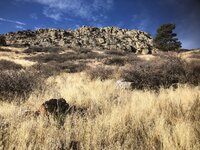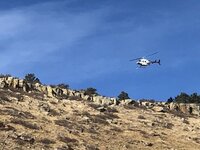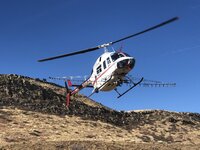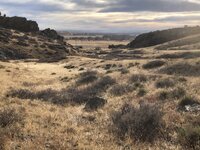What product did you spray?We got 540 acres of cheatgrass on prime mule deer and elk winter range sprayed today! If all goes well we should get another 500+ acres tomorrow. I can’t wait to see it this coming spring. The deer and elk are going to love it!
View attachment 351575View attachment 351577View attachment 351582
You are using an out of date browser. It may not display this or other websites correctly.
You should upgrade or use an alternative browser.
You should upgrade or use an alternative browser.
Mule Deer Populations on the Decline? By Dr. Michael Street
- Thread starter Justin Crossley
- Start date
HighUintas
WKR
- Joined
- Feb 2, 2020
We are using Rejuvra and getting 4+ years control of cheatgrass. The lifespan of cheatgrass is the soil is 3 to 5 years.
Here’s some pics from the 500+ acres we sprayed today.
View attachment 352132View attachment 352133View attachment 352134View attachment 352136
That is awesome. So glad to see people trying to get rid of cheatgrass
We sprayed Rejuvra on 128 acres last fall and it's incredible how well it works. To a line from where we did spray vs didn't spray is impressive. Glad you guys area doing something about it!We are using Rejuvra and getting 4+ years control of cheatgrass. The lifespan of cheatgrass is the soil is 3 to 5 years.
Here’s some pics from the 500+ acres we sprayed today.
View attachment 352132View attachment 352133View attachment 352134View attachment 352136
mtnrunner260
WKR
- Joined
- Aug 6, 2012
When it was still Esplanade I got a quote for 500 acres and it was 30K.
Hopefully it's comes down and continues to due so.
Hopefully it's comes down and continues to due so.
Yes, Rejuvra is expensive. You can ask those that have tried it...most will likely say that it's worth every penny! The long-term cheatgrass control and wealth of benefits speak for themselves! We have taken full advantage of grant $ to fund many of the large scale projects that we have sprayed. It's also possible to pool $ with several interest groups. Several land managers in Wyo are spraying thousands of acres of cheatgrass. If you are seriously interested I would contact some of the land managers in Wyoming and ask them how they have funded their large-scale cheatgrass control programs.
Here are a couple more photos you may want to check out. I took these photos when I was gathering data from 4 different mule deer winter range sites. We monitored and collected annual antelope bitterbrush growth at the end of the 2021 growing season from plants where cheatgrass was controlled and immediately adjacent nonsprayed sites. There were 10 plants harvested in each. 5 of the longest leaders were measured/plant and weighed. The top row of annual bitterbrush growth (top photo) was from 10 plants x 5 leaders each where cheatgrass was controlled. The bottom row (top photo) was 10 plants x 5 leaders each from nonsprayed plants. The bottom photo illustrates the combination of leader growth from the 10 total plants in sprayed (L) vs nonsprayed (R) plants.
Longest leader growth, biomass of leader growth, and total number of leaders/antelope bitterbrush plant were counted. From these we were able to compute the total weight of annual bitterbrush growth/plant. The results are pretty amazing. The means from the 4 sites was 13.8 lbs/bitterbrush plant where cheatgrass was controlled vs only 1.9 lbs/bitterbrush plant in nonsprayed. If my math is correct, that is a 7x or 86% increase in bitterbrush growth where cheatgrass is controlled!
The fresh leader growth not only is longer but thicker in diameter. The leaves are also a lot more robust. We have found this same thing is true with mountain mahogany and other deer browse species. One thing we plan on monitoring in the near future is the nutritional differences between browse species in the sprayed vs adjacent nonsprayed areas. I'm sure there will be dramatic differences in not only quantity but quality of shrub browse where cheatgrass is controlled. We will likely look at energy, crude protein, phosphorus, and other nutrients that are essential in mule deer diets.
We will be presenting this data at an upcoming national invasive weed conference. Pretty exciting stuff that ought to benefit mule deer and other wildlife!
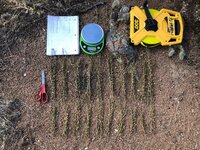
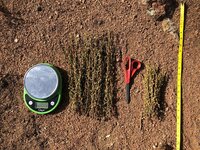
Here are a couple more photos you may want to check out. I took these photos when I was gathering data from 4 different mule deer winter range sites. We monitored and collected annual antelope bitterbrush growth at the end of the 2021 growing season from plants where cheatgrass was controlled and immediately adjacent nonsprayed sites. There were 10 plants harvested in each. 5 of the longest leaders were measured/plant and weighed. The top row of annual bitterbrush growth (top photo) was from 10 plants x 5 leaders each where cheatgrass was controlled. The bottom row (top photo) was 10 plants x 5 leaders each from nonsprayed plants. The bottom photo illustrates the combination of leader growth from the 10 total plants in sprayed (L) vs nonsprayed (R) plants.
Longest leader growth, biomass of leader growth, and total number of leaders/antelope bitterbrush plant were counted. From these we were able to compute the total weight of annual bitterbrush growth/plant. The results are pretty amazing. The means from the 4 sites was 13.8 lbs/bitterbrush plant where cheatgrass was controlled vs only 1.9 lbs/bitterbrush plant in nonsprayed. If my math is correct, that is a 7x or 86% increase in bitterbrush growth where cheatgrass is controlled!
The fresh leader growth not only is longer but thicker in diameter. The leaves are also a lot more robust. We have found this same thing is true with mountain mahogany and other deer browse species. One thing we plan on monitoring in the near future is the nutritional differences between browse species in the sprayed vs adjacent nonsprayed areas. I'm sure there will be dramatic differences in not only quantity but quality of shrub browse where cheatgrass is controlled. We will likely look at energy, crude protein, phosphorus, and other nutrients that are essential in mule deer diets.
We will be presenting this data at an upcoming national invasive weed conference. Pretty exciting stuff that ought to benefit mule deer and other wildlife!


Last edited:
Thank you for the articleI think most hunters would agree that it seems like mule deer populations have been on the decline over the last few decades. But, is that reality or just how we feel based on our experiences over the years and hearing stories of "the good old days"? Are some states doing better than others? Does a higher population correlate to better trophy potential? Find out the answers to these and other questions you may have in the article below by Dr. Michael Street.
Mule Deer Populations on the Decline?
We sold it to the grower at $1100/gal and it's a 5oz use rate. At the time Bayer was offering a $500/box discount if you bought 5 gallons worth. Cost per acre was $48.72/acre with application fee but over 5 years that's $9.74/acre.How much per gallon? We need about 5 million gallons for SE Oregon.
Sent from my SM-G986U using Tapatalk
JustCarr
FNG
- Joined
- Jan 26, 2019
Interesting. Do you have a study you could post? I'd be interested in reading it.Actually, the research exhibits that during drought years Mule deer tend to expand their range and fair better.
Sent from my BBB100-1 using Tapatalk
Interesting you say that. I just saw a couple deer in any area I haven't ever seen deer the last 3 years and I drive by there every day. Been a pretty bad drought year in this area.Actually, the research exhibits that during drought years Mule deer tend to expand their range and fair better.
I just compiled a table with mule deer game camera data from 3 sites we have been monitoring this past year. The indicated numbers are how many deer were in photos taken at the 3 paired sites each month. The Rejuvra and check game cameras were set up immediately adjacent to each other on critical mule deer winter range. The Rejuvra treated sides were sprayed 2 to 3 years prior to this study and had 98 to 100% cheatgrass control 2 to 4 years after treatment. The sites included mountain mahogany, antelope bitterbrush, rabbitbrush and a diverse list of native sub-shrub, forb, and grass species.
It's pretty easy to visualize the strong preference mule deer have for the lush and nutritious leader growth, native forbs, and grass found on sites where cheatgrass was controlled! We collected leader growth biomass in these areas and I'm in the process of getting that data tabled. To add to this story I am hoping we get shrub leader growth and possibly forb nutrition analysis done in the next year.
One of the most important lessons I hope to share is that not only is there more browse biomass available but the nutritional value is much higher where cheatgrass is controlled. This is definitely a game changer for mule deer habitat restoration in cheatgrass infested areas.

It's pretty easy to visualize the strong preference mule deer have for the lush and nutritious leader growth, native forbs, and grass found on sites where cheatgrass was controlled! We collected leader growth biomass in these areas and I'm in the process of getting that data tabled. To add to this story I am hoping we get shrub leader growth and possibly forb nutrition analysis done in the next year.
One of the most important lessons I hope to share is that not only is there more browse biomass available but the nutritional value is much higher where cheatgrass is controlled. This is definitely a game changer for mule deer habitat restoration in cheatgrass infested areas.

Last edited:
I thought I would also post a link to the most complete mule deer habitat guideline publication that I have been able to find. It splits the Western US into different regions to specifically discuss those locations.
In regard to the question about deer expanding their range in drought years. Here in Colo we had super bad drought in fall/winter 2020 with exceptional moisture in spring 2021. We then had historic drought from July through December this fall/early winter. So far my game camera counts are overall slightly lower than the same months last year. I am also seeing a proportionately higher preference to the cheatgrass controlled side so far this winter. In fact, the deer are hardly spending any time in the cheatgrass infested areas and concentrating browsing where there was fairly lush growth of natives.
As you can see from my table there were very few deer photos taken this summer at the 3 sites. The does pretty much disappeared from these sites once it came close to time for birthing fawns. I'm pretty sure many of the does migrated to higher elevation where there was more lush growth and water. I thought it was interesting that the few deer photos that were taken during the summer months were bucks.
The does returned with larger than normal sized fawns this spring but a little lower overall numbers than winter 2020/21 It was exciting to see fawns that were so healthy and larger in size this winter. I contribute their larger size to the health of the does and nutrition that they gained this spring by migrating to higher elevation and larger areas with high quality browse and water. We finally just received our first deep snow this winter. It will be interesting to follow in the coming months.
My guess is that winter browse nutrition and growth is significantly worse in drought years where there is cheatgrass competition so mule deer need to cover larger areas with possibly poorer browse to make up for drought conditions. If there is deep snow in drought years there likely is a trade-off.
We've been excited to start monitoring the new 1,000 acre area we just sprayed cheatgrass from time 0. I'm hoping we can show the dramatic vegetation changes that occur from time 0. We just got another set of game cameras that we will set up possibly this week to monitor deer this winter before cheatgrass is controlled and natives respond. There are also elk in this area so it should be interesting!
As you can see from my table there were very few deer photos taken this summer at the 3 sites. The does pretty much disappeared from these sites once it came close to time for birthing fawns. I'm pretty sure many of the does migrated to higher elevation where there was more lush growth and water. I thought it was interesting that the few deer photos that were taken during the summer months were bucks.
The does returned with larger than normal sized fawns this spring but a little lower overall numbers than winter 2020/21 It was exciting to see fawns that were so healthy and larger in size this winter. I contribute their larger size to the health of the does and nutrition that they gained this spring by migrating to higher elevation and larger areas with high quality browse and water. We finally just received our first deep snow this winter. It will be interesting to follow in the coming months.
My guess is that winter browse nutrition and growth is significantly worse in drought years where there is cheatgrass competition so mule deer need to cover larger areas with possibly poorer browse to make up for drought conditions. If there is deep snow in drought years there likely is a trade-off.
We've been excited to start monitoring the new 1,000 acre area we just sprayed cheatgrass from time 0. I'm hoping we can show the dramatic vegetation changes that occur from time 0. We just got another set of game cameras that we will set up possibly this week to monitor deer this winter before cheatgrass is controlled and natives respond. There are also elk in this area so it should be interesting!
Ekendust
FNG
- Joined
- Dec 2, 2021
Hey all
1) Does anyone know what the "ideal" B ratio was for this study? Was it 1:1 or skewed more towards 1:4 as one would expect to see in a trophy management strategy?
ratio was for this study? Was it 1:1 or skewed more towards 1:4 as one would expect to see in a trophy management strategy?
2) I thought fig. 3 had some really remarkable findings. Fig 3 shows that both Texas and North Dakota are doing exceptionally well. I would like to know how a comparison of certain other parameters may have been at play here such as; average precipitation, hunter participation (specifically mule deer hunter participation), elevation as it may pertain to the severity of winter storms, and lastly interspecies competition with white tailed deer.
3) If you compare just Idaho, Wyoming, Colorado, and Utah; Idaho scores the lowest of the four in Mule deer population per acre and all three Wyoming, Colorado, and Utah all have a relatively similar score. However, Idaho and Utah both score fairly high in figure 2 (Quality Metric per State). I am curious how the author would explain the correlation. I wonder what Quality Metric parameter or parameters these states share, if any.
Thank you so much for sharing this article. I'm a new member on this forum and a complete novice Mule deer hunter. I thought the article was incredibly well done, but it did leave me with a few questions that the cited articles didn't quite answer (at least that I saw).I think most hunters would agree that it seems like mule deer populations have been on the decline over the last few decades. But, is that reality or just how we feel based on our experiences over the years and hearing stories of "the good old days"? Are some states doing better than others? Does a higher population correlate to better trophy potential? Find out the answers to these and other questions you may have in the article below by Dr. Michael Street.
Mule Deer Populations on the Decline?
1) Does anyone know what the "ideal" B
2) I thought fig. 3 had some really remarkable findings. Fig 3 shows that both Texas and North Dakota are doing exceptionally well. I would like to know how a comparison of certain other parameters may have been at play here such as; average precipitation, hunter participation (specifically mule deer hunter participation), elevation as it may pertain to the severity of winter storms, and lastly interspecies competition with white tailed deer.
3) If you compare just Idaho, Wyoming, Colorado, and Utah; Idaho scores the lowest of the four in Mule deer population per acre and all three Wyoming, Colorado, and Utah all have a relatively similar score. However, Idaho and Utah both score fairly high in figure 2 (Quality Metric per State). I am curious how the author would explain the correlation. I wonder what Quality Metric parameter or parameters these states share, if any.
Thanks!Hey all
Thank you so much for sharing this article. I'm a new member on this forum and a complete novice Mule deer hunter. I thought the article was incredibly well done, but it did leave me with a few questions that the cited articles didn't quite answer (at least that I saw).
1) Does anyone know what the "ideal" Bratio was for this study? Was it 1:1 or skewed more towards 1:4 as one would expect to see in a trophy management strategy?
2) I thought fig. 3 had some really remarkable findings. Fig 3 shows that both Texas and North Dakota are doing exceptionally well. I would like to know how a comparison of certain other parameters may have been at play here such as; average precipitation, hunter participation (specifically mule deer hunter participation), elevation as it may pertain to the severity of winter storms, and lastly interspecies competition with white tailed deer.
3) If you compare just Idaho, Wyoming, Colorado, and Utah; Idaho scores the lowest of the four in Mule deer population per acre and all three Wyoming, Colorado, and Utah all have a relatively similar score. However, Idaho and Utah both score fairly high in figure 2 (Quality Metric per State). I am curious how the author would explain the correlation. I wonder what Quality Metric parameter or parameters these states share, if any.
1) The B2D ratio in this study was used based on how they were trending over time. Are they near their objective? Trending out of their upper and lower bounds? etc. Each state and unit is managed differently, like you point out.
2) A more sophisticated model could certainly be built with the right data sets. It would take a good amount of effort and collaboration between states, which I have heard from biologists isn't very common.
3) The model for each state was built on each state's harvest rate, historical population trend, B
Ekendust
FNG
- Joined
- Dec 2, 2021
Thank you so much for answering my questions. Even though I sadly don't get a chance to use my degree very much, I have a degree in Wildlife Ecology so this is the stuff that makes me tick! haha.Thanks!
1) The B2D ratio in this study was used based on how they were trending over time. Are they near their objective? Trending out of their upper and lower bounds? etc. Each state and unit is managed differently, like you point out.
2) A more sophisticated model could certainly be built with the right data sets. It would take a good amount of effort and collaboration between states, which I have heard from biologists isn't very common.
3) The model for each state was built on each state's harvest rate, historical population trend, Bratio trend, and pop/acre. Each parameter in the model had nearly equal weighting, resulting in differing quality metrics solely based on population/acre. The quality metric = Q(Pop/acre, Harvest Rate, Pop trend, B
Ratio trend).
trchandl2
FNG
- Joined
- Nov 23, 2021
- Location
- South Carolina
Cool article and great thread. I'm really interested in the restoration efforts.
I've hunted the eastern Sierra Nevada mountains for over 25 years. We noticed that the mule deer population as been in decline for about the last 10 years. Tags are way down too.I think most hunters would agree that it seems like mule deer populations have been on the decline over the last few decades. But, is that reality or just how we feel based on our experiences over the years and hearing stories of "the good old days"? Are some states doing better than others? Does a higher population correlate to better trophy potential? Find out the answers to these and other questions you may have in the article below by Dr. Michael Street.
Mule Deer Populations on the Decline?
Last edited:
Similar threads
- Replies
- 24
- Views
- 2K
- Replies
- 0
- Views
- 229
Featured Video
Latest Articles
- TT#64 Josh Boyd Elk Hunting Strategies for Every Season
- Aaron Davidson of Gunwerks
- TT#63 Dirk Durham’s Art of Elk Calling
- BIG Buck Stories with the Dirty Giants Podcast
- TT#62 Brian Barney Hunting Bulls without Calling
- Hoyt Alpha AX-2 SD Review
- Kuiu Kenai vs Outdoor Vitals Vario Hooded Jacket Review
- Hoyt RX-9 Ultra Review
- Hunting Vampire Bucks & Building an Optics Kit
- Darton Sequel ST2 35 Review


